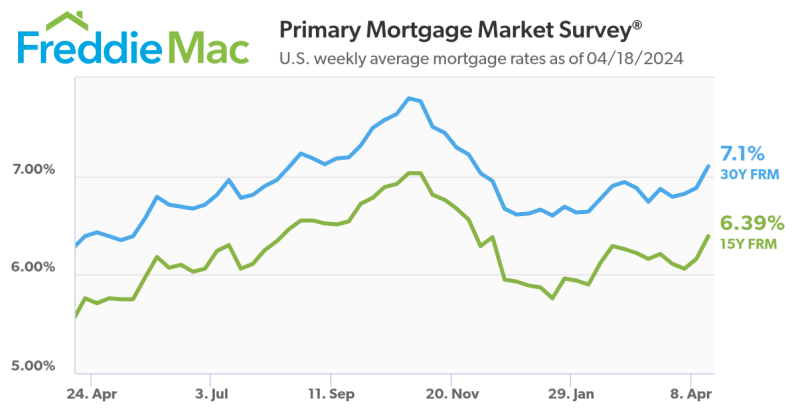Advertisement
World Alliance Financial celebrates continued growth at Michigan national sales office
Inflation, the Fed and mortgage ratesMortgagePress.comHSH's 30-year Fixed-Rate Mortgage Indicator, hybrid adjustable-rate mortgages
Rates for the most popular kinds of mortgages rose a little this
week, as HSH's 30-year Fixed-Rate
Mortgage Indicator (FRMI) increased by six basis points (.06
percent) to close the survey week at an average 6.60 percent. The
overall average for 5/1 hybrid adjustable-rate mortgages (ARMs)
ended HSH's national survey at an average 6.35 percent, an increase
of 13 basis points.
HSH's FRMI captures 30-year mortgages of all sizes, including
conforming, the new "expanded conforming" and jumbo. The FRMI has
been published as a continuous series since the early 1980s.
Separate statistical series for conforming and jumbo loans have
long been available to HSH clients. We expect to make data
available for the new 'expanded' product within the next few
weeks.
True conforming 30-year fixed-rate mortgages (FRMs) lifted by
six basis points this week, pressed higher by rising Treasury
yields. Preliminary results for the "expanded conforming" FRM shed
18 basis points (0.18 percent) after Freddie Mac announced a new
commitment to buy them from lenders, while "true"
jumbos—still largely shunned by investors and typically
priced far higher than their conforming counterparts—added
only four basis points to finish Friday at 7.23 percent.
A few themes emerged from this week's markets. The economic news
that came out—which was, largely, not as bad as
feared—prompted some investors to opine that the Fed would
cut interest rates by just 25 basis points (if at all). Such talk
prompted at least some investment money to shift out of
ultra-secure Treasury bills and bonds in search of better returns
elsewhere, boosting interest rates to varying degrees across the
spectrum.
The seemingly relentless surge in oil and food prices is
prompting renewed concerns about a global inflation spiral.
Domestically, we've been enduring a firm inflation environment, but
price pressures for raw materials, gasoline and grains are adding a
new level of misery to other economies, bringing further
expectation of future price increases. If rising prices begin to
trim economic growth both here and abroad, the corresponding
fall-off in demand for certain materials may serve to temper those
costs, but will do little in the case of demand outstripping the
available supply of some commodities, such as rice.
The Fed can do little to directly influence the price of oil or
food, but if the Fed signals that it is essentially done trimming
interest rates, it may regain some of the market's confidence that
they'll adhere to the "price stability" portion of the "dual
mandate" to which the Fed is bound.
The other portion of the mandate is to achieve "full
employment." Hiring has been slightly underwater over the past few
months, and it's likely that the April employment report won't have
positive news to report either. New unemployment claims have
generally been rising in recent weeks, but there was an unexpected
drop in new claims during the week ending April 19, when just
342,000 new applications for assistance were filed at state
windows. That was the best weekly number since early March; this is
encouraging news, even though it's unlikely that claims will hold
at that lower level.
An improvement of sorts in March was reflected in the Chicago Federal Reserve Bank's
National Activity Index (NAI). The NAI, which reflects how well the
economy is performing relative to its potential for growth,
improved to a less-negative -0.78 during March, rising from a -1.28
mark. If nothing else, it is an indication that although the
economy is weak and well below its potential, the downturn doesn't
appear to be getting much deeper at the moment.
That isn't the case for consumer moods. Gasoline near or over $4
per gallon, property tax and mortgage issues, a stumbling economy,
and rising prices have all but killed enthusiasm. According to the
University of Michigan survey of
Consumer Sentiment, moods measured by their survey are at a 26-year
low reading of 62.6 in April, down about seven points from an
already bleak March report. Also, the ABC News/Washington
Post poll of Consumer Comfort continues to find greater
discomfort, with that yardstick sporting a -40 reading during the
week of April 19, the lowest figure of the current cycle.
Perhaps "stimulus checks" will serve to improve moods. Released
in sequence by the last two digits of a recipient's Social Security
number, those payments will start to hit mailboxes shortly ... and
are likely to be reinvested into the gas tank and the grocery
store.
One place it probably won't go is toward a downpayment on a
home. Home sales fell again in a challenging March period. Existing
home sales eased by two percent, landing at a 4.93 million
annualized rate of sale. With demand slowing, the stock of
available housing inventory returned to 9.9 months' worth of
supply. The homes that did sell, however, did so at an improved
price, which nudged 0.9 percent higher to $206,000.
New home sales fared worse. The near negative nine percent
decline was way softer than expected, with new homes presently
moving at a 526,000 annualized sales pace. Prices slipped by 3.6
percent during March as inventory available ballooned to 11 months,
the highest number in the downturn. At some point, probably not
that far in the future, the housing market will reach a point where
even the low levels of demand will start to overtake the available
inventory.
Reports covering manufacturing have been uneven, and that's not
likely to change just yet. Orders for durable goods declined by 0.3
percent in March, somewhat below forecasts. Despite the decline,
some better news lurked below the headline, as the sub-index
covering business spending rebounded from negative two percent to
just flat zero. If recent patterns persist, we could see a positive
number in the next month or two. Regional Fed surveys of factory
health found a decline-to-zero activity in the Richmond Federal
Reserve district, but a good rebound from negative five to +12 was
observed in the Kansas City area. It was the first positive number
there in the past three months.
As noted above, the Federal Reserve Policy-Setting Committee
meets for a two-day meeting shortly. We're expecting to see a
quarter-percentage point cut in the Fed Funds and Discount Rates,
and predict that the release announcing the change will note that
financial markets have found at least some semblance of stability
for the moment, as well as that inflation pressures are now the
dominant concern of the Fed—a signal that, barring any new
emergency, the rate-cutting cycle is done.
At this point, with the "real" cost of money at or below zero,
there's little more to be gained by cutting rates anyway, and
little inflationary damage that the another quarter-percent of
"insurance" might cause.
This is a very dicey time for the economy. Growth remains
subpar, inflation seems to be resurging, and food and energy costs
will sap a fair portion of the hoped-for stimulus. If the economy
doesn't respond favorably to the boosts which have already been put
in place, tax policy may need to change to put a few more dollars
into consumer pockets on a more permanent basis (read "tax cuts").
In the present political environment, however, that seems unlikely,
so we may just have to cross our fingers and hope for the best.
The Fed move will only affect the Prime Rate, which in turn will
hit Home Equity Line of Credit Rates. Some of those are starting to
bounce along interest rate "floors" already. Mortgage rates will
probably nudge higher; presently, the only thing which would cause
a meaningful downturn in rates would be a sudden spate of investor
demand (unlikely as lenders and investors continue to lick their
wounds and build loan-loss reserves) or a huge new appetite for
"investments" by Fannie Mae
or Freddie, both of which have the cash to buy loans and a place to
park them.
For more information, visit www.hsh.com.
About the author





